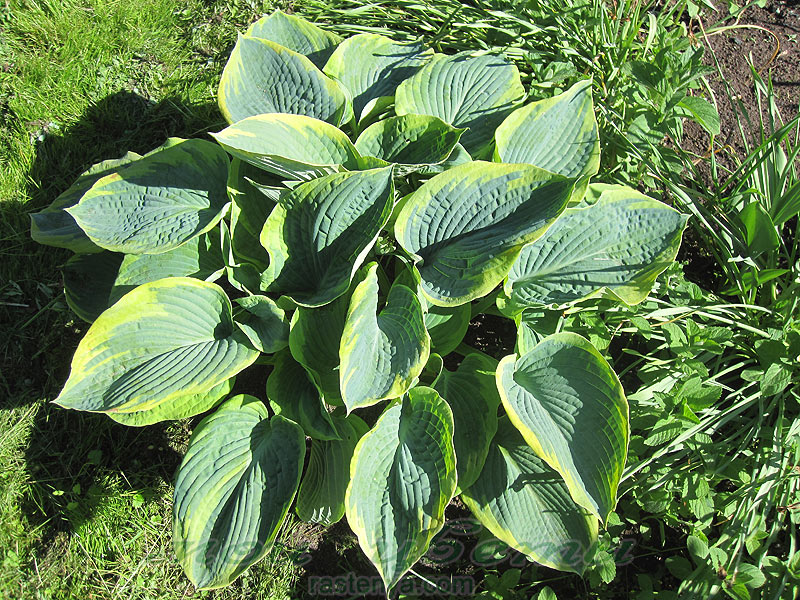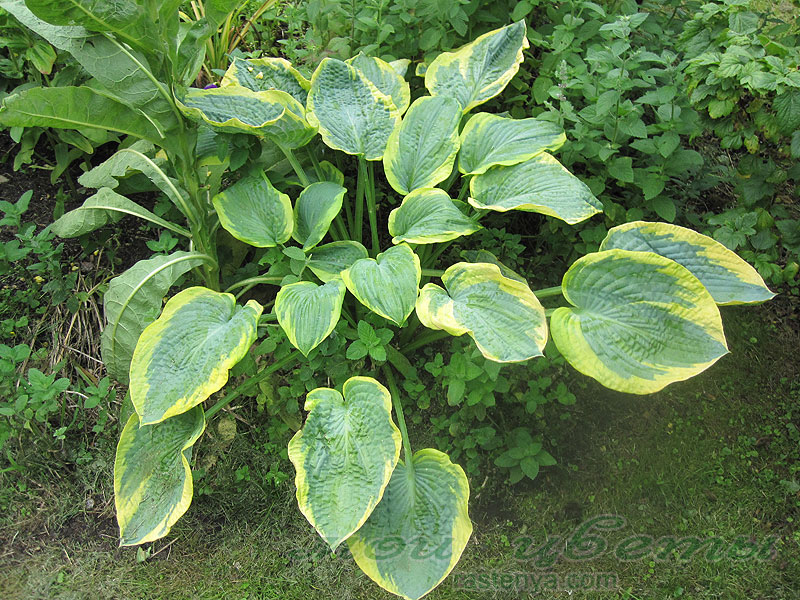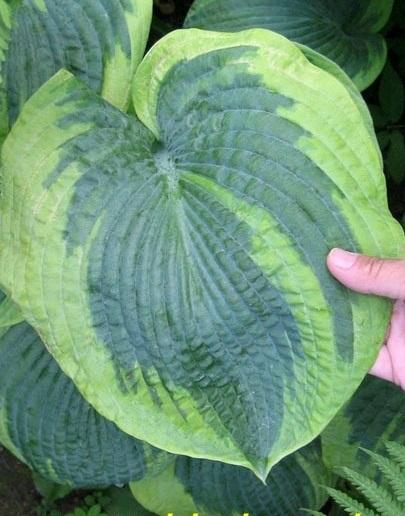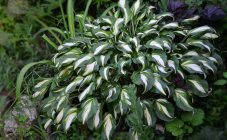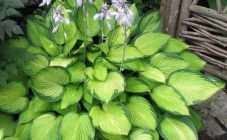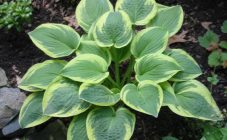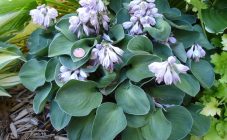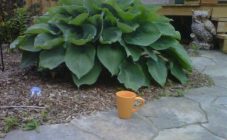Content:
Hosta is an unpretentious perennial plant. These flowers should be grown outdoors. Depending on the variety, they prefer shade or sunny locations. They reach a height of 10 centimeters. Host leaves can be smooth or wavy, matte or shiny. Foliage colors range from blue to pink.
A favorable period for planting hosts is the beginning of spring.
Description of Siebold hosts
Khosta Siebold originates from Japan. The leaves of the plant are dense, have an oval shape with an interesting corrugated texture, covered with bloom. Lavender inflorescences. The stem on which the flower is located has no leaves.
Seeds ripen in a capsule. In one place, they can grow for twenty or more years.
History of the hosta Francis Williams variety
Hosta Siebold was named after the botanist P. Siebold. The hosta variety Siebold Aureomarginata is hybrid and belongs to the old Japanese varieties. In 1970, the name was changed to Frances Williams (France Williams, Frances Williams, Francis Williams). The plant got its name in honor of Mrs. F. Williams, who was the owner of the Pennsylvanian host nursery. She noticed a different plant among the host Siebold of the elegans variety. The flower had a yellow border, thus a new cultivar was discovered. Siebold's host Frances Williams is propagated in America by clonal micropropagation.
Description of host frances williams
The plant is perennial, reaching a height of 65 centimeters. The leaves are azure blue with a yellow border along the edge. The leaf shape is rounded. The flowering period is mid-summer (late June-early July). White inflorescences are located on a short stem. The diameter of the flowers is 5 centimeters, they are collected in clusters of 8 pcs.
Hosta frances williams is characterized by unpretentiousness and frost resistance. Any type of soil is suitable for cultivation. Protect the plant from the wind, as there is a risk of leaf damage. Hosta Frans Williams grows well in partial shade.
The variety is resistant to disease. The pests that most commonly affect plants are slugs.
Agricultural technology of cultivation
Hosta Francis Williams, like other hosts, reproduces by dividing the bush, grafting, growing from seeds and vegetatively. What is the most efficient way?
The division of the bush is carried out in late spring or late summer. The growth period depends on the size. If you separate a small part from the bush, then more time is needed for growth.
The method of vegetative propagation is the most effective for the host. It is used on an industrial scale. The essence of the method is to grow a plant in a test tube.
Seed propagation is the most difficult way. This process is laborious and time consuming. Seeds should be planted in April. Germination rate is 70%. Before sowing, the seeds are treated with a growth stimulant or kept in the cold for a month. The soil and containers for planting must be disinfected. For this, potassium permanganate or alcohol is used. Drainage is poured at the bottom of the tank, then soil. Moisten the soil well and plant seeds. Cover the container from above with foil.
The place is chosen in the shade with a temperature of + 18-25 degrees. Seedlings will appear after two to three weeks. Seedlings are watered moderately. Place containers in a well-lit area, but not in direct sunlight. It should be planted after the appearance of the first pair of leaves.In new containers, a quarter of the soil should be sand. The sprouts should be hardened by removing the film for a while. After a week, the film is removed completely. When the air temperature outside the window begins to warm up to +18, the seedlings need to be taken out to the garden for a short time.
The method of propagation with the help of cuttings consists in separating the sprout with the root from the adult plant. With this method, the planting material is immediately ready for planting.
The hosta is planted in open ground in early spring or late summer.
Planting material should be chosen with elastic roots, the length of which is 12 centimeters, and the presence of two or three buds.
Before planting a plant in the garden, you should prepare the place. It is necessary to add top dressing (humus or compost) to the soil and dig it up. For planting, prepare holes 30 centimeters deep. The distance between the bushes should be kept 120 centimeters, since the adult plant reaches a diameter of 90 to 130 centimeters. The stems should be above the ground and not below. After planting, you need to water the plant, and also cover the roots with mulch. Crushed bark or peat is used as mulch. Mulching allows you to retain moisture. Watering is necessary every 3 days.
Caring for the hosta after planting consists in regular loosening and watering (2 times a week).
During the season, you need to apply fertilizing three times: during growth, during the flowering period and after the plant has faded. Supplements containing nitrogen, potassium and phosphorus are suitable as fertilizers. Compost and humus are introduced in autumn.
Hosts have been growing in one place for over 20 years. But it is recommended to plant them every five years.
Hosts that are already growing in the garden need feeding at the beginning of spring. During the growth period, they need the following mineral supplements: nitrogen, phosphorus and potassium fertilizers. After fertilizing, the flowers are watered abundantly. Thus, the fertilizer will reach the roots.
In the fall, before the first frost, pruning is carried out. The procedure consists in trimming the stem with the flower. Leaves should not be touched, they are removed in the spring when they rot. Immediately after flowering, the stem is cut off so that the hosta does not waste energy on ripening the seeds.
Plants are rarely susceptible to disease. The disease that occurs is phyllostictosis. Brown spots are characteristic manifestations of the disease. Plants with such signs should be destroyed, the soil should be disinfected. Fungicides are used against other diseases (gray rot, sclerotinia).
Holes in the leaves of the hosta appear due to slugs. Rubble or broken shells, which are poured under the plants, will help against them. Insecticides will help fight insects.
For winter, in regions with a temperate climate, plants should be covered for the winter. To do this, you should prepare the flower for wintering. Under the leaves, mulch the soil using grass, sawdust and peat.
In the spring, all this will rot, and the plant will receive a portion of organic fertilizers. Leaves are not removed during pruning, thanks to this, the bushes will better endure the winter. The paws of coniferous trees are used as a shelter. It is undesirable to cover with various films, because the bushes will not be able to breathe, pests take root well under them.
Advantages and disadvantages
The plant has the following advantages and disadvantages compared to other varieties.
The advantages of the Francis Williams hosta variety are:
- unpretentiousness;
- cold resistance;
- almost not susceptible to disease;
- can grow in shade and partial shade.
Disadvantages of the hosta Frances Williams variety:
- moisture-loving;
- when sunlight hits the leaves, they change color from blue to green.
Thus, the process of growing unpretentious hosts of the Francis Williams variety is considered from above. It has a blue leaf color. Can be grown by seeds, cuttings, vegetatively and by dividing the bush. The most suitable way to grow in the garden is with cuttings. The plant does not require much care.Subject to the basic rules, a bush will grow on the garden plot, which will serve as its decoration.
